
Dunkeld Cathedral: Scotland’s sacred heart
My first impression of Dunkeld’s Cathedral of St Columba was on a cold day in late November, with the setting sun lengthening the shadows and frost already breathing its silent spell on the well-mown grass.
Standing on the bank of the River Tay and surveying the Cathedral from the south, I assumed that the building had taken place in two stages: the first part, now roofless, I imagined must have been abandoned and allowed to fall into ruin, and later, a much more habitable structure had been added as an extension. Either that, or the congregation in the western half preferred singing hymns under the stars.
But this isn’t how it happened at all.
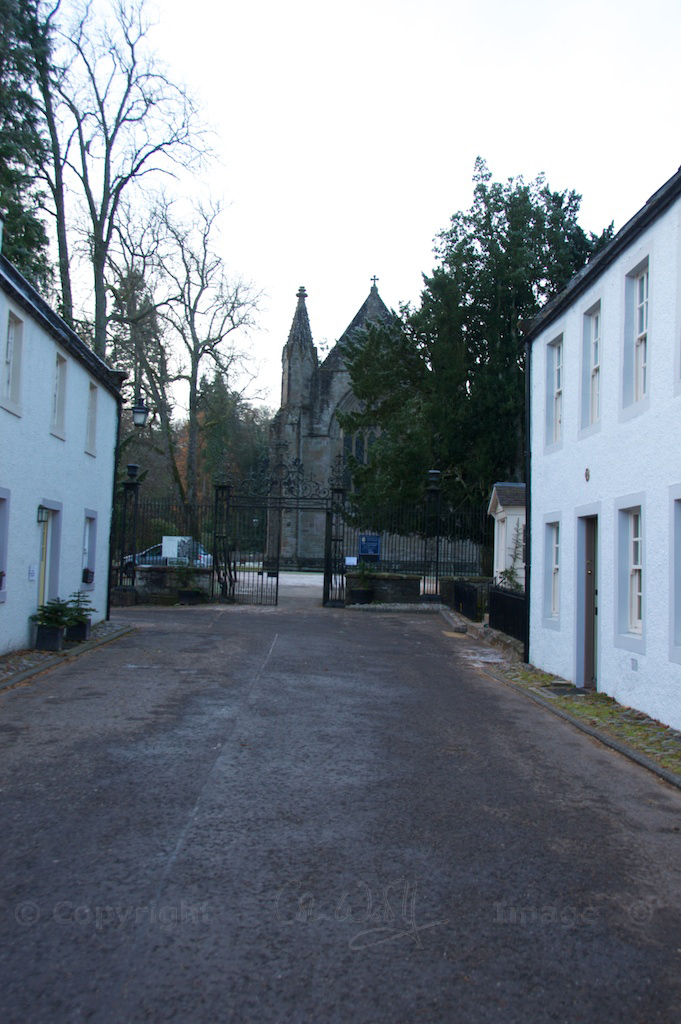
The tranquil riverside location was first enjoyed by a community of Culdees, who built a monastery here around 730 AD. A hundred years later, Kenneth MacAlpin, traditionally recognised as the first King of Scotland but now believed by Neil Oliver and others to be the first King of Pictland, had the simple wattle walls re-built in red stone.
This was the 9th century, and repeated Viking raids were wreaking havoc with monasteries up and down the coast: precious artefacts were being seized, and monks slaughtered. St Columba’s monastery on Iona was a favourite target, so Kenneth MacAlpin had the saint’s relics brought to Dunkeld for safe keeping; his bones were buried under the chancel steps. A beautifully carved ‘Apostles’ Stone’, thought to depict Christ’s disciples, dates from around the same time, and is preserved in the chapter house, having been rescued from its temporary role as a gatepost.
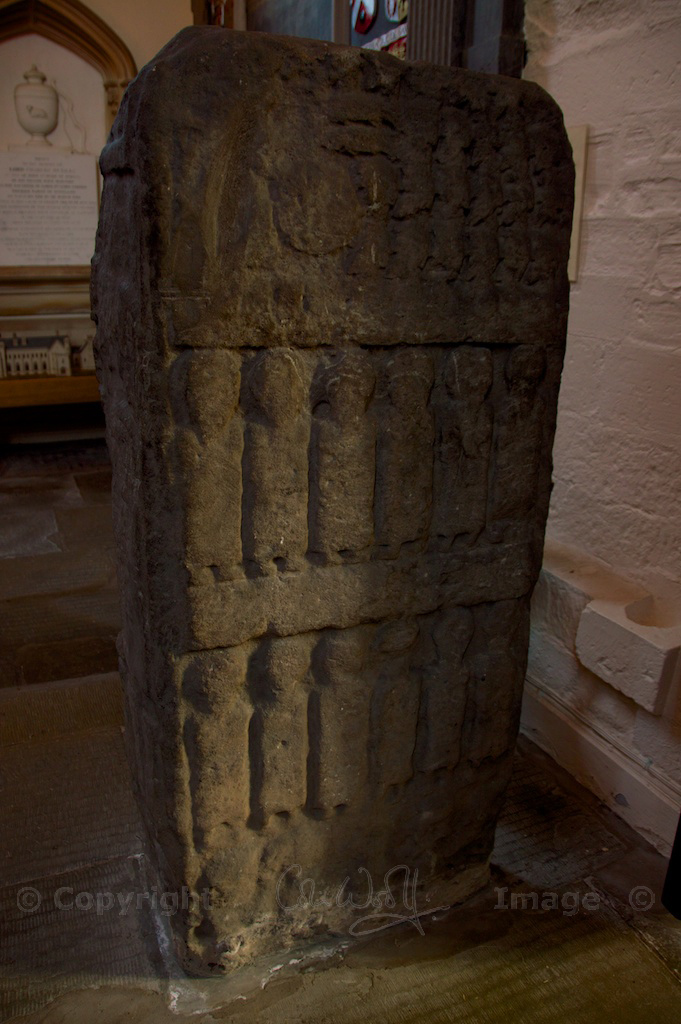
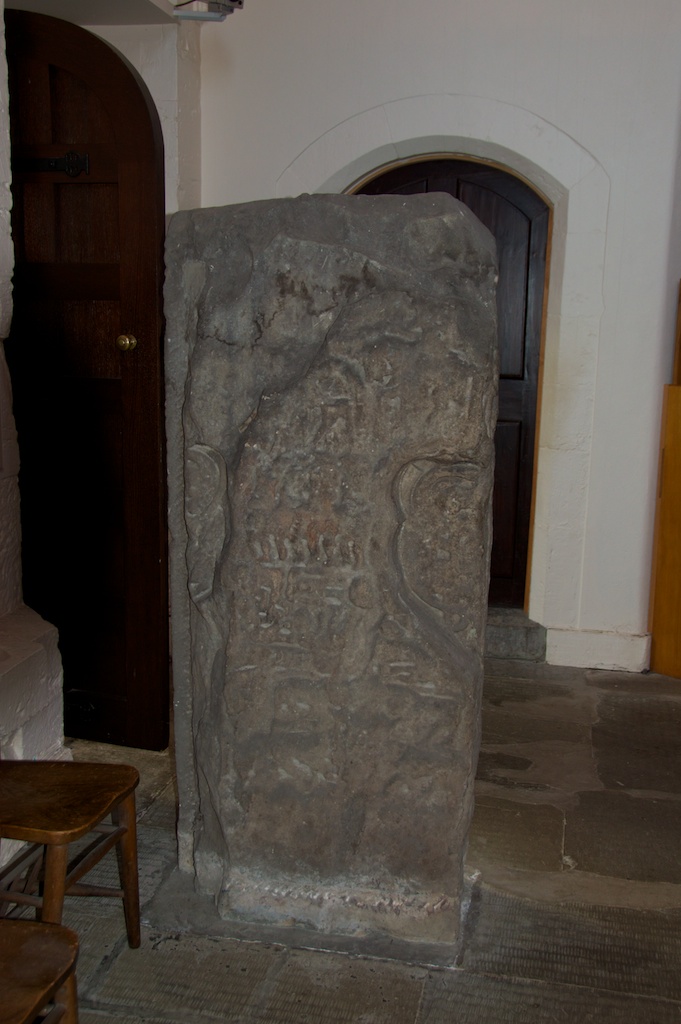
During the Reformation in the late 1500s, Columba’s bones were taken to Ireland, but there is a persistent belief that some forgotten relics still lie buried in the cathedral grounds.
Dunkeld grew to become the administrative headquarters of the early Scottish Church, and I was surprised to discover that it, too, suffered Viking raids. This forced the Church to move its centre even further east, to St Andrews. (I’d have thought that the Vikings could easily have approached St Andrews by sea.)
This is an information board outside the church, and it includes a floor plan. Surprisingly, the choir at the eastern end is the oldest surviving part, dating from around 1350; but it looks much more recent, having been fully restored in the early 20th century so that it could be used as a parish church. However, the reddish blocks that are incorporated into the wall of the eastern gable were apparently taken from the original Culdee monastery.

Over the 14th and 15th centuries the cathedral was either extended or embellished by successive generations, and the 96-foot-high tower at the north-west corner was added in 1501. Desecration came soon afterwards, however, with the Scottish Reformation in 1560, when any symbols of the Catholic faith were destroyed. Dunkeld was stripped of its glory, and even parts of the roof were removed; fortunately, the practice of worship was continued by a loyal congregation in the part that remained intact.
In 1689 the first Jacobite uprising led to a battle in which much of Dunkeld, including the Cathedral, was set ablaze. The commanding officer of the defending forces, Lt Col William Cleland, heroically held the Cathedral and its surroundings against a dangerously confident Highland army that had just swept to victory at Killiecrankie. Cleland lost his life in the conflict, and he is buried in the nave.


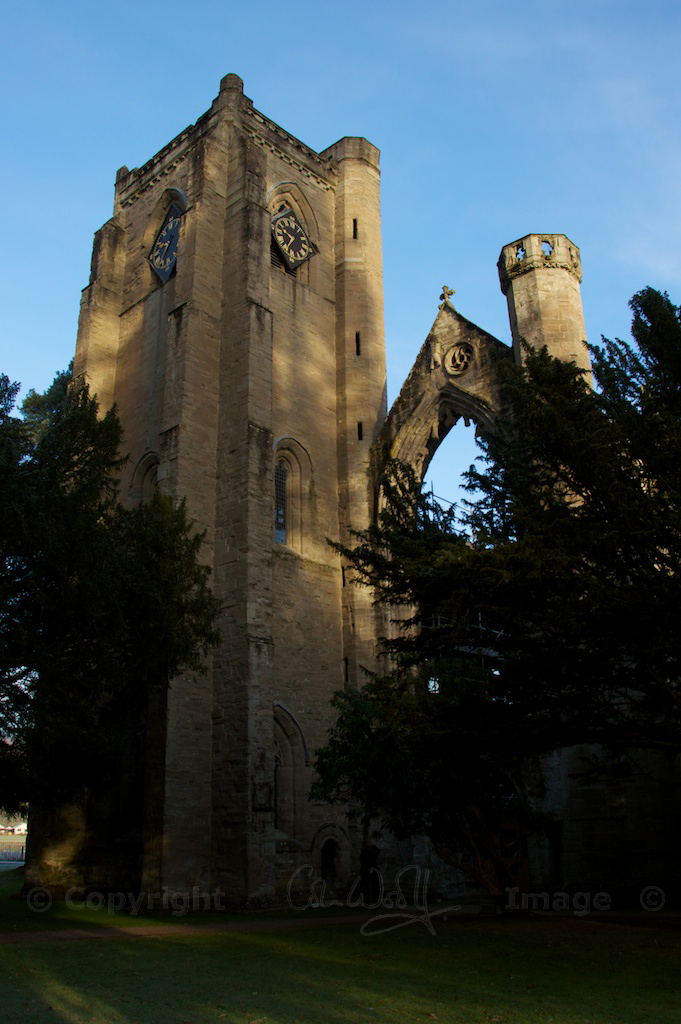
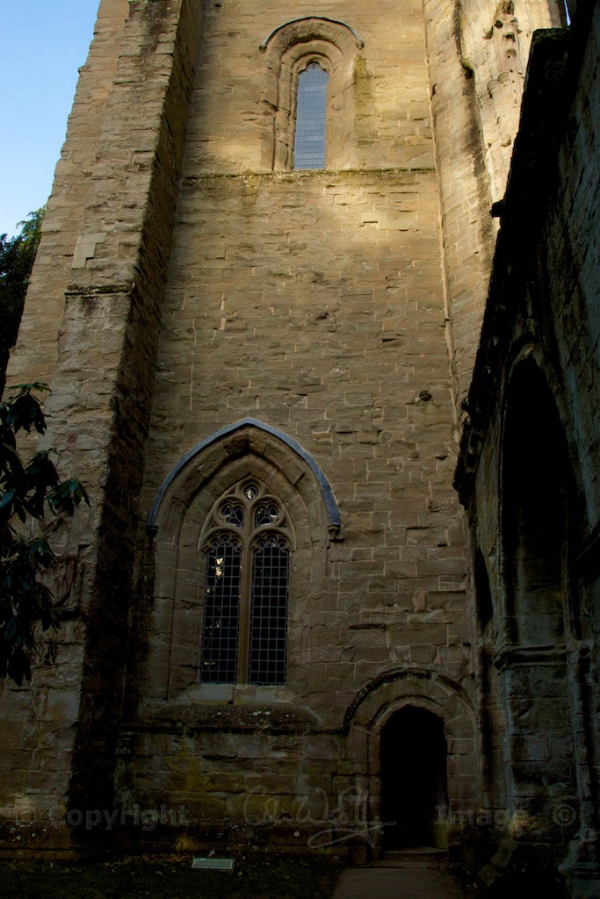
In a little room underneath the tower is a display of carved stones, some rescued from the graveyard during the Reformation, and others dating from many centuries before. Among these is a Pictish carving of a warrior on horseback, and a ‘hogback’ stone, long and ridged like a roof tile, with curious striations etched into its surface. As far as I can discover, these gravestones with a curved or ‘hogbacked’ shape were favoured by Danish settlers, and surviving examples date from the 10th to the 12th centuries; their markings are thought by some historians to represent a tiled roof as a shelter for the dead person.

There are features of the Cathedral that I didn’t have time to examine, but the light was failing and our main priority was to photograph it from the outside before it got too dark. This means that I missed seeing the tomb of Alexander Stewart, the infamous Earl of Buchan whose cruelty earned him the nickname of ‘the Wolf of Badenoch’; and the headless effigy of Bishop Sinclair, chaplain to William Wallace and Robert the Bruce. However, I have to admit that effigies are not my most favourite thing, headless or otherwise! So I’m not quite as sad as you might imagine.

Added to this, the quiet but dark recesses of the small ante-rooms had me glancing into every shadow, and checking every doorway. The atmosphere in the main body of the church was calm, serene and cold, but in the chapter house, while I was taking photos of the Apostles’ Stone, I started to feel slightly spooked. Perhaps it was just the confined space.

As we walked around the grounds, we admired the immensely tall Douglas firs and the lovely oaks and sycamores. Cast by the setting sun, long fingers of shadow were reaching the cathedral walls; and the grass was already crisp with frost, garnished with a scattering of dead leaves. We stopped to look at a wizened old holly bush, whose branches were growing in knobbly spirals. Whether this was by nature or human encouragement, I have no idea.
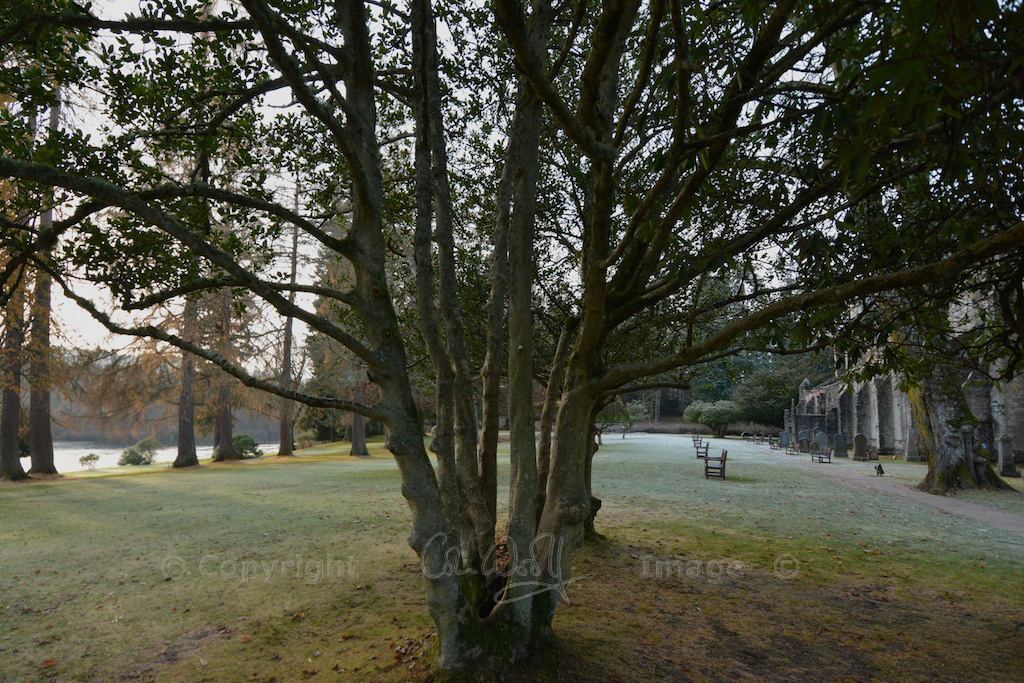
The whole place was about to dip into twilight, and blackbirds were giving their bedtime alarm calls. We prised our frozen fingers from our cameras, closed the iron gates behind us, and left them in peace.
Dunkeld Cathedral hosts regular Sunday services for worship and Communion. Outside of these times, the opening hours are: 9.30 am to 6.30 pm April to Sept; 9.30 am to 4 pm October to March. There’s a small museum in the Chapter House, which also houses the mausoleum of the Dukes of Atholl. The Friends of the Cathedral offer guided tours, which may be booked in advance (see the Dunkeld Cathedral website, below). Admission is free but donations are appreciated.
Sources:
- Historic Scotland
- Dunkeld Cathedral
- Undiscovered Scotland
- RCAHMS Canmore
- Scottish Churches
- Museums and Galleries of Scotland
- ‘A History of Scotland’ by Neil Oliver
Photos copyright © Colin & Jo Woolf
I’m sorry for the quality of some of my internal shots – the flash was bouncing off the lens hood, which I didn’t realise until later, leaving arcs of shadow in the image.
Read about the Battle of Killiecrankie, which took place just a few miles to the north-west of Dunkeld… these glorious old woods have a peaceful yet haunting atmosphere.





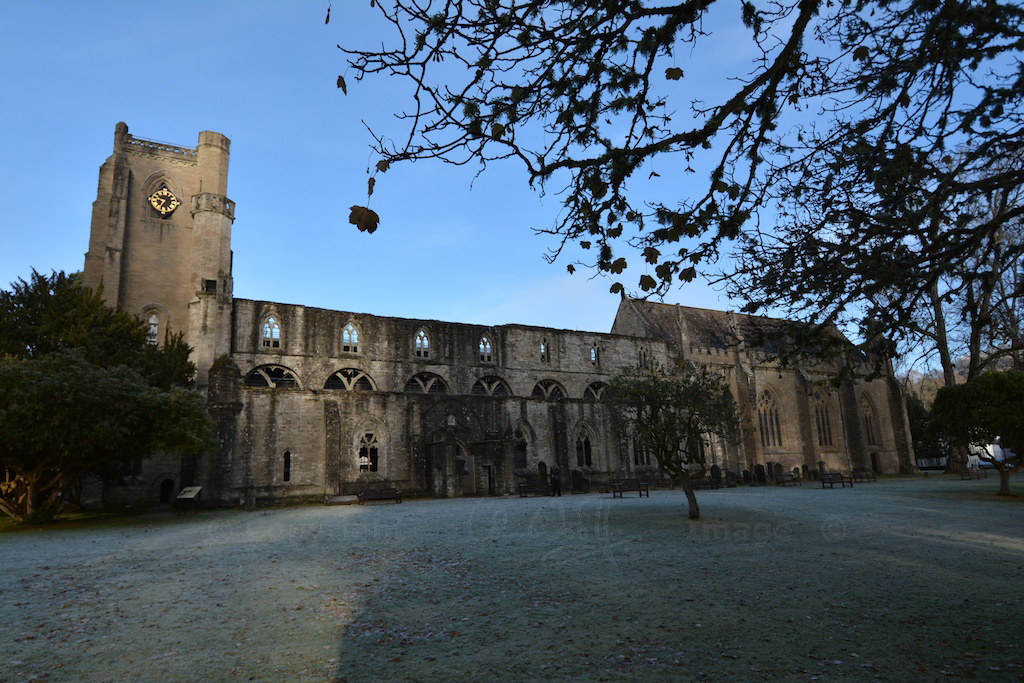









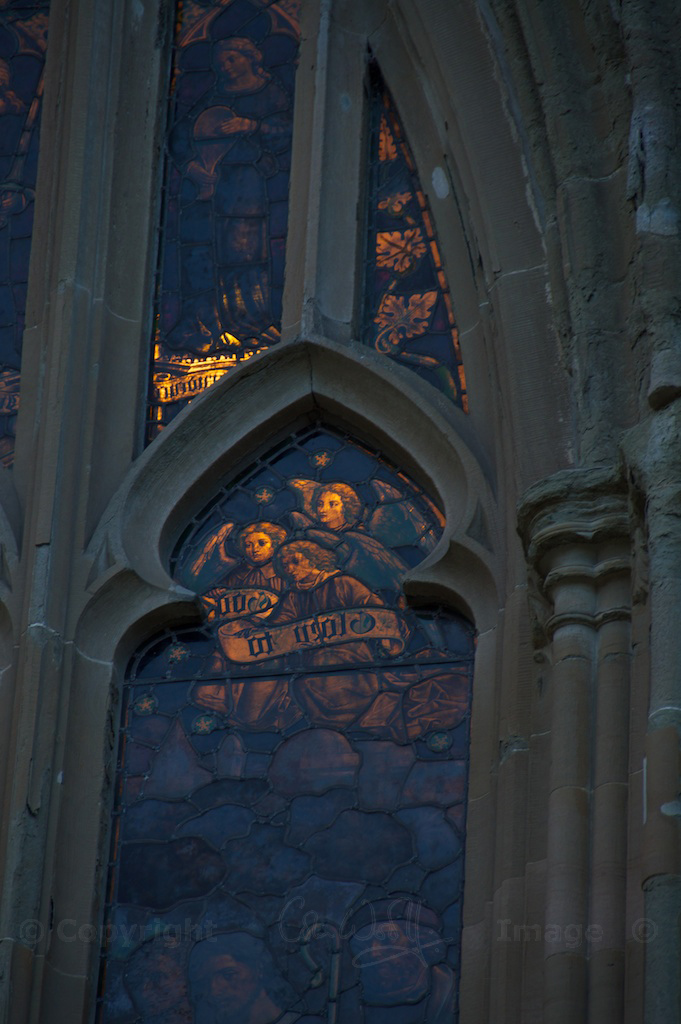







30 Comments
tearoomdelights
I think your photos are beautiful, Jo, photography’s not easy at that time of year but they really give a feel for the place. I didn’t know about the hogback stones, I must go and have a look at them some time. I felt cold looking at your pictures, partly because of the time of year but also because the very mention of Dunkeld makes me feel chilled. It’s such a beautiful little place but very unfortunate in its microclimate, to my mind. I don’t know if it’s anything to do with the history or just the cold, but when I’ve visited Dunkeld Cathedral I haven’t felt terribly comfortable inside and have been glad to get out. Perhaps I’ll try going in midsummer and see if I still feel the same.
Jo Woolf
Thank you very much, Lorna – we had such a limited time for photography, so I’m really glad the pictures convey a sense of the place. It certainly was cold! Dunkeld seems to have a real reputation for chilliness! That’s interesting that you felt uneasy when you visited the cathedral – I felt the same, in the Chapter House and also in the small room under the tower, where the carved stones were. Usually I’d have been fascinated, but in fact I just wanted to get out. It would be good to know if the atmosphere is still the same at midsummer.
Anny
I thought your pictures were amazing, and now with your comments and Lorna’s, I’m itching for a visit! I think we’ve driven past the signs lots of times, so now I’ll have to make sure we actually go there.
Jo Woolf
Thank you, Anny! It would be interesting to know what you make of it. I haven’t visited that many cathedrals – I could probably count them on one hand – but I’m pretty sure that Dunkeld is unique in many ways, and it is in such a photogenic spot!
Rachel
I love old churches and abbey’s and you have made me feel like I have gone round it myself! Lovely photos too. I shall have to try and get up to visit one day – I passed through Dunkeld some years ago when I went to volunteer with the Atholl Estates ranger team, but I never got chance to visit properly. I wonder if the chill will still be there…?
Jo Woolf
Thank you, Rachel! I’m glad you felt as if you’d had a virtual tour. Whenever you visit, I’m pretty sure it will still be chilly. Those monks must have needed their thermals!
Ash
Ahhh! Another wonderful place to visit later this year. [I think there’s a holiday cottage one can rent in the cathedral cloister] I won’t really need to buy that guide book, I’ll just follow up on your marvelous posts.
Jo Woolf
The cottages that we walked past looked quaint and cosy – I’m not sure if the holiday cottage is one of these, but if so it’s very pretty. Thank you, glad you liked the post! 🙂
Carmen Mandel
Another beautiful tour, Jo, thank you. Impressive architecture and history under your feet.
Jo Woolf
It’s a very impressive place – I didn’t really know what to expect, but it’s both an ancient ruin and a fully functioning church. There can’t be many cathedrals like that! Thank you – I’m glad you enjoyed this.
dancingbeastie
I did enjoy this post, in which you perfectly conjured up the atmosphere of the cathedral on a quiet winter’s afternoon. Last year I was ‘volunteered’ onto the board of the Friends of Dunkeld Cathedral. While very much an ignorant newbie, I have visited the cathedral often over the past decade and am enjoying learning more about it and its rich history. You have given us a splendid synopsis.
Jo Woolf
That’s very kind of you to say so – I do appreciate that, because you know the cathedral much better than I do. Your role as one of the ‘Friends’ sounds quite enjoyable! I can see why the monks chose the site for their monastery, as it is just so peaceful. I would love to have seen the cathedral at all its various stages in history, and while it was still intact!
blosslyn
Oh dear, another one to add to the list…..lovely tour Jo, thank you 🙂
Jo Woolf
Thank you very much, Lynne! You would love it, I know! 🙂
Susan Abernethy
Reblogged this on The Freelance History Writer and commented:
Jo Woolf of The Hazel Tree is a friend of The Freelance History Writer and she has done a lovely post about the medieval cathedral in Dunkeld, Scotland. She gives the history and provides some great photos. Enjoy!
Jo Woolf
That’s so kind, Susan, thank you very much for this! I’m so glad you enjoyed it. 🙂
Princess of Eboli History Masquerade
Reblogged this on If this walls could talk and commented:
This pictures are so beautiful, I am going to reblog this pictures and the post, because it is so interesting!!!!
Jo Woolf
I’m delighted to know you enjoyed it. Thank you very much!
periklisdeligiannis.wordpress.com
Magnificent photos! this monument justifies my love for anything Celtic.
Jo Woolf
Thank you very much! Dunkeld seems to blend so many strands of Scottish history in one beautiful building. I’m very glad you enjoyed the ‘visit’!
Scott Marshall
A typically informative – Jo Woolf blog post – lots of ideas and added to the bucket list – it was already on my radar due to the Wolf of Badenoch’s Tomb but will make a destonation now for definite – all the best Scott
Jo Woolf
Thank you, Scott! We were really there too late in the day to do much in the way of photography- the shadows were lovely but contrasty. I could have spent twice as long, but the the light was going. Yes, the Wolf of Badenoch lived up to his name!
Watching Seasons
What a beautiful place, and so much history!
Jo Woolf
Isn’t it lovely?! I had no idea how much history I was going to discover here.
H David Brown
Hi Jo I was born and raised only a few miles away from this wonderful old Cathedral and of course visited many times. Your photographs and description is spot on and I hope encourages many of your readers to visit. Another place nearby is the village of Inver ( where I lived ). Here in a cottage wall is a plaque commemorating the life of the famous fiddler Neil Gow ( best to google him ) Only a mile upstream on the River Brann and accessed from the A9 about 500 yds North of the Dunkeld exit from the A9 is a delightful place called The Hermitage and Ossians Hall overlooking a fine waterfall – very worth the visit especially in late Aug/early Sept when the salmon are trying to leap up the falls. Nearby is the Village of Birnam of Birnam Wood fame as described in the MacBeth
Jo Woolf
What a lovely place to grow up, David! Dunkeld is a beautiful place, and I love the cathedral and its grounds. I shall have to look up Neil Gow! We’ve been to the Hermitage woods several times and I agree that it’s really beautiful – especially in autumn with the river in full spate. We also love the falls by Rumbling Bridge. And the Birnam Oak – what a fabulous tree! Perthshire is so rich in amazing trees. Thank you very much for your kind comments! I hope you continue to enjoy my posts. I’ve been a bit quiet recently as we’re moving house, but hope to bring lots of news soon! Meanwhile best wishes, Jo
Katrina Bathgate
We visited Dunkeld Cathedral this afternoon and upon reviewing the photos afterwards, noticed a misty humanoid shape on the right hand side of the organ on the balcony!
Jo Woolf
Oh my goodness! How spooky! Have you put the photo online anywhere? I’m not aware of any hauntings there, but then I haven’t looked into it!
Charlotte Ferguson
I am trying very hard to get the size of the overall Cathedral, as I’m trying to figure out how to build an N scale modal for my Donald. We fell in love with Scotland and Dunkeld Cathedral in 2007.
Jo Woolf
Hi Charlotte, this image on Canmore may help you: https://canmore.org.uk/collection/1023867 Also if you check this document http://portal.historicenvironment.scot/designation/LB5631 it contains a bibliography of further sources, some of which may be available digitally online, and might be worth investigating.
Sounds like a very interesting project! Best wishes, Jo